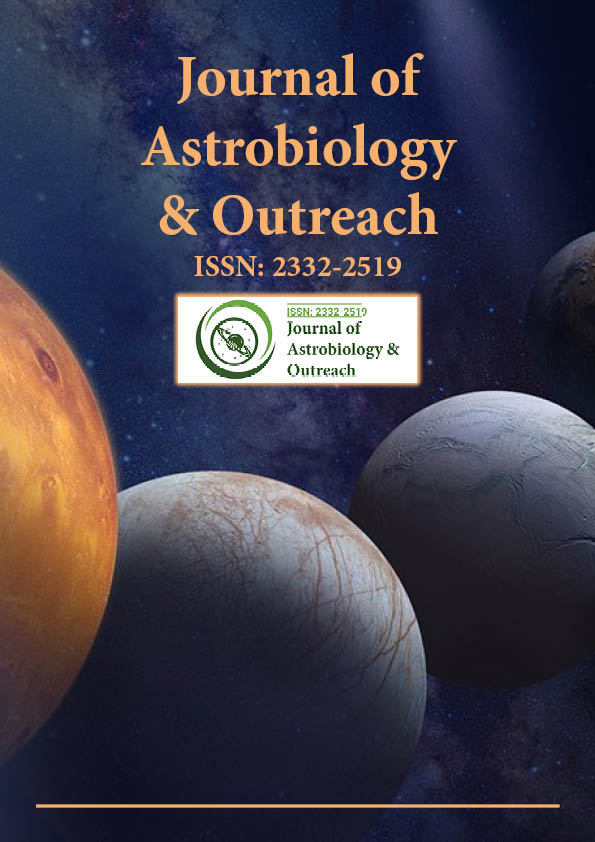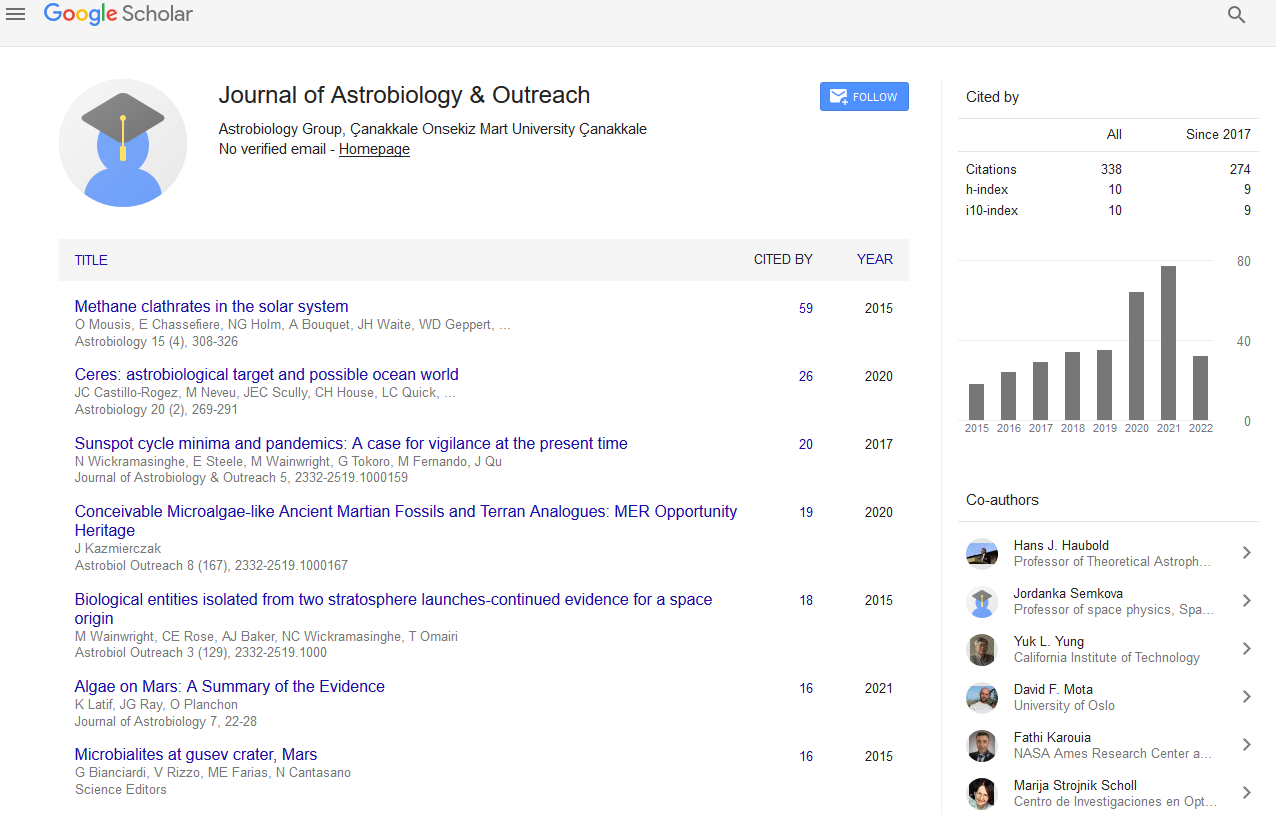Indexed In
- Open J Gate
- Academic Keys
- JournalTOCs
- RefSeek
- Hamdard University
- EBSCO A-Z
- OCLC- WorldCat
- Google Scholar
Useful Links
Share This Page
Journal Flyer

Open Access Journals
- Agri and Aquaculture
- Biochemistry
- Bioinformatics & Systems Biology
- Business & Management
- Chemistry
- Clinical Sciences
- Engineering
- Food & Nutrition
- General Science
- Genetics & Molecular Biology
- Immunology & Microbiology
- Medical Sciences
- Neuroscience & Psychology
- Nursing & Health Care
- Pharmaceutical Sciences
Opinion Article - (2024) Volume 12, Issue 4
Managing Solar Eclipses in the Earth-Moon System: Challenges and Strategies for DRO Missions
Marco Bianchi*Received: 29-Nov-2024, Manuscript No. JAO-24-28018; Editor assigned: 02-Dec-2024, Pre QC No. JAO-24-28018 (PQ); Reviewed: 16-Dec-2024, QC No. JAO-24-28018; Revised: 23-Dec-2024, Manuscript No. JAO-24-28018 (R); Published: 30-Dec-2024, DOI: 10.35248/2332-2519.24.12.368
Description
The Distant Retrograde Orbit (DRO) of the Earth-Moon system is drawing growing interest for space missions and satellite placement due to its unique orbital mechanism and stability. Situated far from the Earth-Moon barycenter, the DRO provides a unique vantage point for scientific observation, as well as potential applications in deep space missions. One of the fundamental considerations for missions operating in the DRO is the need to manage solar eclipses, which occur when the Earth and Moon align in such a way that the satellite or spacecraft in orbit is subjected to the shadow of the Earth or Moon. In this article, we will explain the importance of active solar eclipse avoidance on the DRO, focusing on the implications of solar eclipses on mission operations and the feasibility of methods to minimizing their impact.
The concept of solar eclipse avoidance is essential for any mission operating in space, especially those positioned in orbits like the DRO, which might spend extended periods near the Earth and Moon's shadow. During a solar eclipse, the spacecraft or satellite can experience an absence of sunlight for an extended period, potentially leading to a series of operational challenges. Solar power, which many space missions depends on for energy, would be significantly impacted by the loss of sunlight, affecting power generation, thermal regulation and communication systems. These issues are heightened by the fact that the DRO is highly stable, meaning missions can remain in orbit for extended periods, increasing the frequency of solar eclipses they may experience.
In the Earth-Moon system, solar eclipses happen when the Earth, Moon and Sun align in a straight line. For satellites operating in orbits closer to Earth, such as geosynchronous or low Earth orbits, eclipses are typically short-lived and predictable, with solutions such as storing energy or depending on backup power systems. However, the DRO is situated in a more complex region where both lunar and solar mechanism comes into play. Depending on the spacecraft's position and orbital path, it may be exposed to eclipses that last for several hours, significantly increasing the risks to mission continuity. For example, satellites may experience periods of darkness that prevent their solar panels from generating power, risking mission failure if energy management systems are not sufficiently strong.
To minimize the impact of solar eclipses in the DRO, one potential solution is the development and implementation of active eclipse avoidance strategies. Unlike passive avoidance, which typically depends on orbital design and adjustments to minimize eclipse exposure, active avoidance involves real-time decisions and movements to change the spacecraft's intensifies and orientation. One method to avoid eclipse exposure would be to use onboard propulsion systems to slightly adjust the spacecraft’s orbit when an eclipse is predicted. By executing small course of corrections, a spacecraft could change its path to avoid entering the Earth’s shadow or minimize the duration of shadow exposure. However, such movements require precise calculations and careful monitoring, as the DRO’s unique orbital characteristics mean that even small changes can lead to large shifts in orbital dynamics.
One of the most important aspects of implementing active eclipse avoidance will be the use of predictive algorithms. Advanced simulations and real-time tracking of the spacecraft’s position relative to the Earth, Moon and Sun will be essential for identifying when an eclipse is likely to occur and making decisions in advance to avoid it. These algorithms would take into account the spacecraft’s velocity, orbit and the timing of the eclipse, using predictive models to calculate the optimal course correction. A fundamental challenge in this approach is ensuring that the spacecraft’s propulsion system is efficient enough to make these adjustments swiftly, without wasting energy or time on unnecessary movements.
In conclusion, while the distant retrograde orbit provides unique advantages for space exploration, active solar eclipse avoidance is an essential consideration for missions operating in this region. By developing and refining methods to actively avoid solar eclipses, space missions can ensure continuous operations and improve the feasibility of long-duration studies in deep space. Whether through trajectory adjustments, solar sail propulsion, or advanced predictive algorithms, active eclipse avoidance represents an exciting opportunity for the future of space exploration in the Earth-Moon system and beyond.
Citation: Bianchi M (2024). Managing Solar Eclipses in the Earth-Moon System: Challenges and Strategies for DRO Missions. J Astrobiol Outreach. 12:368.
Copyright: © 2024 Bianchi M. This is an open-access article distributed under the terms of the Creative Commons Attribution License, which permits unrestricted use, distribution, and reproduction in any medium, provided the original author and source are credited.

